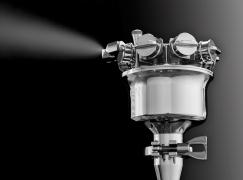Building on our discussion of precise disinfection in critical environments, this blog examines how Dry Fog compares to the Triple Clean method. While Triple Clean focuses on meticulous manual surface cleaning, Dry Fog offers rapid whole-room decontamination using aerosolized Minncare. We break down the strengths of each approach to help you choose the ideal disinfection method for your facility. Check out our Triple Clean blog post to learn more about that disinfection method.
Dry Fog Decontamination
When contamination threatens, every second counts. Our Dry Fog service ensures rapid, whole-room disinfection with unmatched efficiency—without the downtime of manual cleaning. Using aerosolized Minncare—a stabilized peracetic acid solution—this method disperses a dry fog throughout the space, disinfecting every surface and the air itself.
What is Dry Fog?
Dry Fog utilizes specialized fogging equipment to generate microdroplets that remain airborne longer, reaching all surfaces and ensuring thorough disinfection.
Key Benefits
- Speed: Up to 40,000 square feet can be fogged in just 6 hours—far quicker than manual cleaning.
- Total Coverage: Ideal for large, complex spaces, including behind equipment and within air systems.
- Residue-Free: The fog breaks down into harmless byproducts like vinegar, water, and oxygen.
- Labor-Efficient: A single technician can manage the fogging process, reducing costs.
Ideal Use Cases for Dry Fog
- Facility-wide decontamination
- Large cleanroom suites
- Emergency contamination response
- Preventative maintenance with minimal downtime
- Complex cleanroom designs
- ISO 5-8 Cleanrooms
What is Triple Clean?
Triple Clean is a meticulous, three-step manual surface disinfection process designed for thorough decontamination. It begins with a germicidal surfactant application, which effectively removes contaminants. Next, a sporicidal disinfectant is applied to target resilient bacterial spores. Finally, an IPA rinse ensures all residual disinfectant is removed, leaving surfaces clean and residue-free. This method is ideal for detailed surface cleaning, ensuring precision and reliability in controlled environments.
Triple Clean vs. Dry Fog: A Side-by-Side Comparison
Not sure which method suits your needs? Here’s a quick comparison:
| Feature | Triple Clean | Dry Fog (Minncare) |
|---|---|---|
| Method | Manual, multi-stage surface cleaning | Automated, whole-room aerosol decontamination |
| Area Coverage | Targeted areas, smaller rooms, specific equipment | Whole rooms, large areas, complex geometries, entire volumes |
| Speed for Large Areas | Slower, labor-intensive for large areas | Much faster, efficient for large areas |
| Labor | More labor-intensive, especially for larger areas | Less labor-intensive, especially for larger areas |
| Penetration | Surface-focused | Excellent penetration, reaches all surfaces, including hard-to-reach areas and air handling systems |
| Residue | Minimal due to IPA rinse | Minimal, breaks down into harmless byproducts (acetic acid, water, oxygen) |
| Best Use Cases | Routine surface cleaning, smaller areas, detailed equipment cleaning, residue-sensitive areas | Large area decontamination, major contamination events, routine maintenance in large areas, complex rooms, minimizing downtime |
| Ideal Room Requirements | None | Ideally HEPA filtered with independent air supply (vacant building acceptable alternative) |
Why Choose Dry Fog Over Triple Clean?
Dry Fog offers significant advantages, especially for larger areas and situations demanding rapid, comprehensive disinfection:
- Speed & Efficiency: Dry Fog is significantly faster, capable of fogging up to 40,000 sqft in just 6 hours—far less time than a Triple Clean for the same area. Some services complete fogging and aeration in under 3 hours, minimizing downtime.
- Whole Room Decontamination & Superior Penetration: Unlike surface cleaning, Dry Fog fills the entire room volume, reaching ventilation systems, behind equipment, and other hard-to-reach areas for comprehensive disinfection.
- Reduced Labor Costs for Large Areas: One technician can manage the fogging process for an entire space, reducing labor costs compared to Triple Clean’s manpower-intensive approach.
- Ideal for Complex Geometries: Cleanrooms often contain intricate equipment and layouts. Dry Fog ensures uniform disinfectant distribution, which manual cleaning can struggle with.
- Shutdowns & Major Contamination Events: For rapid decontamination during facility shutdowns, post-contamination events, or routine maintenance, Dry Fog minimizes bioburden while maximizing efficiency.
Choosing the Right Method
Every cleanroom has unique needs. Triple Clean offers meticulous, hands-on surface disinfection—ideal for targeted areas and routine cleaning. Dry Fog provides rapid, whole-room decontamination, perfect for larger spaces, complex environments, and situations requiring fast turnaround.
Need guidance? Let our experts help you select the best approach for your cleanroom’s unique requirements. Contact us today!
